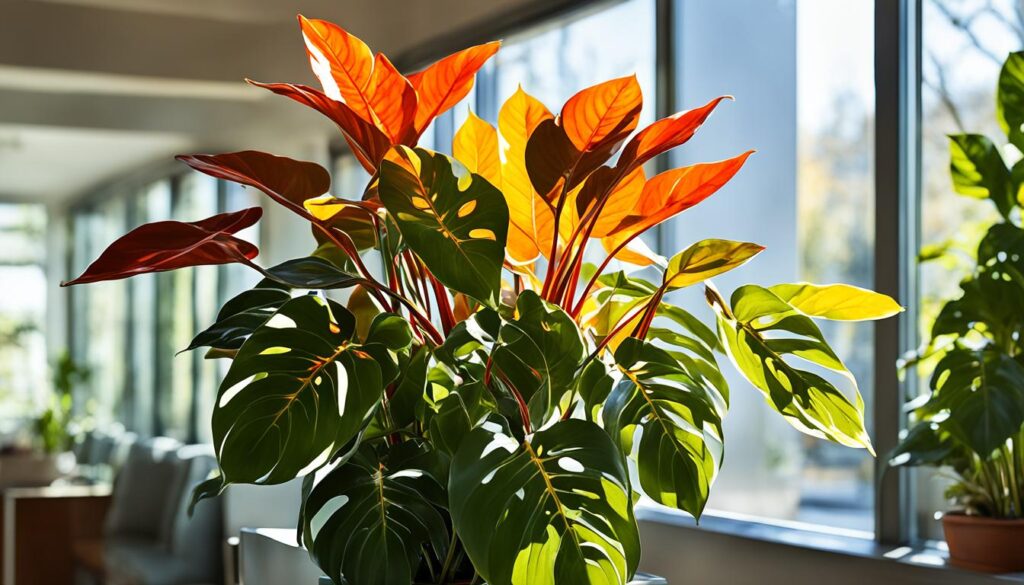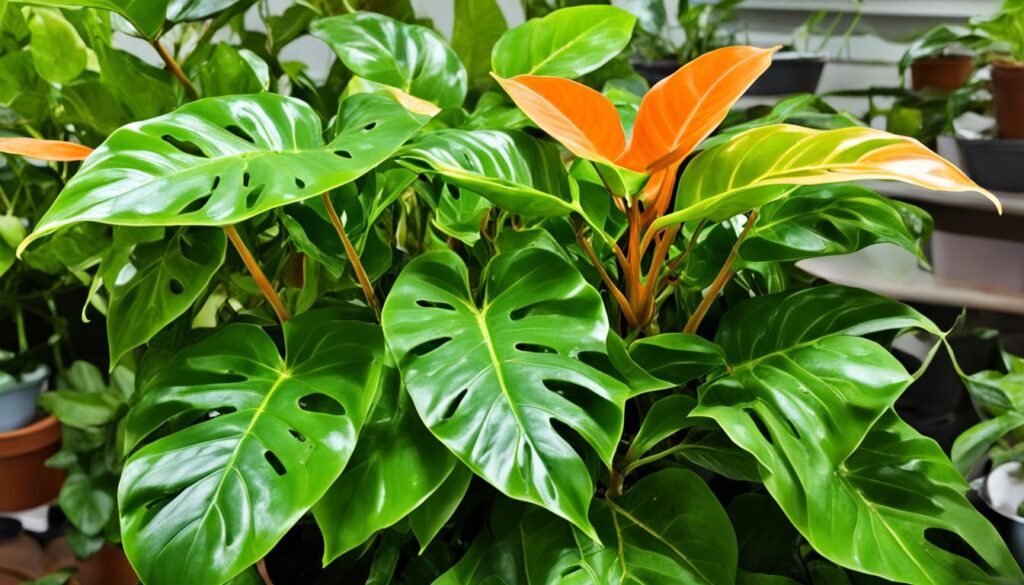Did you know the Philodendron Prince of Orange can grow a lot in just one year? This tropical houseplant is part of the aroid family. It’s known for its bright colors and fast growth. As it gets older, its leaves change from bright yellow-orange to deep green, making it stand out indoors.
If you’re new or experienced with houseplants, this guide will help you care for your Philodendron Prince of Orange. We’ll talk about the best lighting, watering, pruning, and how to grow it. With these tips, your plant can grow up to 2 feet tall.
Key Takeaways
- The Philodendron Prince of Orange can double in size within a year with the right lighting
- Mature plants can reach up to 2 feet tall and wide
- Leaves transition from yellow-orange to deep green as the plant matures
- Requires bright, indirect light and well-draining potting mix
- Needs regular watering and moderate humidity to thrive
Introduction to the Philodendron Prince of Orange
The Philodendron ‘Prince of Orange’ is a rare and captivating plant. It belongs to the Araceae family. It comes from the tropical parts of South America. People love it for its unique colors and features.
Origin and Unique Characteristics
This plant grows on the ground under the shade of tall trees in its home. It was made by crossing the Philodendron erubescens, known for its eye-catching leaves. The Prince of Orange gets its special look from this parent plant.
Color Transformation During Maturation
As it grows, the Philodendron Prince of Orange changes color. Its leaves start bright orange and turn deep green as it gets older. They may show shades of yellow-bronze, salmon, and orange before settling to dark green.
New leaves often bring back the orange color to the plant.
“The Philodendron Prince of Orange is a rare non-vining upright hybrid bred from the Philodendron erubescens, sought after for its unusual coloring.”
This tropical plant loves bright, indirect light and well-draining soil. With the right care, it can add vibrant color and texture to any spot, inside or outside.
Light Requirements for Optimal Growth
The Philodendron Prince of Orange is a beautiful houseplant that loves bright, indirect light. It does well in a well-lit spot but should not get direct sunlight. Direct sunlight can harm its leaves.
It’s best to put your Philodendron Prince of Orange near an east or west window. Here, it gets warm, filtered light. Or, you can use a sheer curtain to soften the sunlight. This creates the perfect light for your plant.
Not enough light makes leaves look dull and weak. Too much direct sunlight can burn the leaves. To keep your plant healthy, find the right mix of brightness and indirect light.
“The Philodendron Prince of Orange is a true showstopper when it comes to light requirements. With its vibrant hues and lush, glossy leaves, this plant truly comes alive in bright, indirect lighting conditions.”
Give your Philodendron Prince of Orange the best lighting for it to stay beautiful. This ensures your mature plant looks great, showing off its amazing color transformation and rapid growth.

Soil Preferences and Potting Mix
To make sure the Philodendron Prince of Orange grows well, it needs the right soil. These plants like a loose, well-draining potting medium. This mix should allow for good air and moisture.
A good DIY soil mix is made of equal parts perlite, peaty soil, and orchid bark. Add a bit of gravel too. This mix is perfect for draining well.
Well-Draining Soil Mixture
Instead of making your own mix, you can use a aroid potting mix made for tropical plants. These mixes have the right drainage and nutrients. It’s important to make sure the soil isn’t packed too tight to avoid root rot and other issues.
- Use a soil mix with equal parts perlite, peaty soil, and orchid bark
- Add a small amount of gravel to further enhance drainage
- Commercial aroid potting mixes designed for tropical plants can also be used
- Avoid compacted soil to prevent root rot and other problems
“The ideal pH range for Philodendron Prince of Orange soil is between 5.0 and 6.0, slightly acidic.”
Give the Philodendron Prince of Orange a soil mix that drains well and is rich in nutrients. This way, the plant will grow well and show off its bright leaves and tall growth.
Watering Needs and Techniques
Proper watering is key for the Philodendron Prince of Orange to grow well. This plant likes soil that’s a bit moist but can’t handle too much water, which causes root rot. It’s better to check the soil often and water deeply when the top 1-2 inches feel dry.
Letting the soil dry out a bit between waters is crucial. Philodendrons don’t like to stay in wet soil.
Signs of Overwatering and Underwatering
Leaf discoloration hints at watering problems. Yellow leaves might mean the plant is getting too much or too little water. Yellow leaves with brown spots often point to overwatering. Fully yellow leaves and brown, crispy spots suggest underwatering.
Checking the soil moisture is key to figuring out the watering issue and fixing it.
- Philodendron Prince of Orange needs 0.5 cups of water every 9 days when not exposed to direct sunlight and is potted in a 5″ pot.
- Philodendron Prince of Orange prefers the soil to dry out between waterings and should be watered regularly.
- Watering frequency for the Philodendron Prince of Orange should be once or twice a week, with increased watering needs in the summer.
By keeping an eye on the soil moisture and adjusting the watering, gardeners can help the Philodendron Prince of Orange stay healthy. This way, they can avoid problems like leaf discoloration and leaf curling from too much or too little water.

“The key to happy Philodendron Prince of Orange is to keep the soil consistently moist, but never soggy. Err on the side of caution and allow the top inch or two to dry out between waterings.”
Humidity and Temperature Conditions
The Philodendron Prince of Orange loves warm, humid places, just like its home in the tropics. Keeping the right humidity and temperature is key for its growth and health.
Humidity is crucial for the Philodendron Prince of Orange. It needs a humidity of 50-70% for its leaves to stay lush and healthy. You can create the perfect humidity by placing your plant in a bathroom or using a humidifier.
For temperature, the plant likes daytime warmth between 60-80°F. Make sure it’s away from cold drafts, air conditioning vents, or other cold spots. These can harm its growth.
By mimicking the tropical conditions it’s used to, your Philodendron Prince of Orange will thrive. It will keep its vibrant, high humidity leaves.
“Providing the right humidity and temperature for your Philodendron Prince of Orange is crucial for its long-term health and growth.”
Creating the perfect philodendron prince of orange mature environment is important. It means balancing humidity and temperature right. This way, you’ll enjoy its beautiful colors and lush leaves for many years.
Fertilizing Schedule for Healthy Foliage
The Philodendron Prince of Orange doesn’t need much food but a little help during spring and summer can make it thrive. Use a 10-10-10 formula or fish emulsion as your fertilizer. Just follow the instructions on the label to avoid giving too much.
This plant comes with a slow-release fertilizer in its potting mix. So, you don’t need to feed it for the first six months. Remember to fertilize every two weeks from spring to summer.
When the plant is dormant, in fall and winter, you should fertilize less. This is because it doesn’t need as many nutrients. Too much fertilizer can cause problems like yellow leaves or roots turning black.
If you over-fertilize, stop feeding it, wash the soil, cut off any dead parts, and watch for signs of recovery. Always use organic fertilizer and follow the directions carefully. This way, you’ll keep your Philodendron Prince of Orange looking great.

“Moderation is key when it comes to fertilizing the Philodendron Prince of Orange. Over-application can lead to nutrient buildup and damage to the plant.”
Pruning and Maintenance Routine
The Philodendron Prince of Orange is easy to care for and doesn’t need much pruning. Still, regular care keeps it healthy and bright.
Pruning this plant means taking off dead or dying leaves now and then. Unlike some philodendrons, it doesn’t need a lot of trimming. Just a simple cut with scissors or secateurs keeps it looking great.
- Remove any dead, damaged, or discolored leaves to encourage new growth and improve the plant’s appearance.
- Prune any errant or overly long stems to maintain a neat, compact shape.
- Avoid cutting more than 20% of the foliage at one time to prevent stress on the plant.
Keeping the leaves clean is also key for the Philodendron Prince of Orange. Use a damp cloth to wipe the leaves, removing dust and dirt. This helps the plant make food better. Do this every few weeks for the best look.
Rotating the plant is another important step. The Prince of Orange leans towards the light. Rotating the pot helps it grow evenly and stops it from leaning.
“Proper pruning and maintenance can help the Philodendron Prince of Orange thrive and maintain its vibrant, mature appearance.”
With regular pruning and care, your philodendron prince of orange mature plant stays healthy, beautiful, and shows off its bright colors.
philodendron prince of orange mature Propagation Methods
The Philodendron Prince of Orange is a stunning tropical plant with vibrant foliage. It changes color as it grows. You can easily make new plants from stem cuttings. This lets you grow more plants and share the beauty of the Philodendron Prince of Orange.
The best time to start new plants is in spring and summer. This is when the plant grows the most. Cuttings taken then are most likely to grow roots and become new plants.
- Take a cutting just below a node, where new roots will form. The node is the point on the stem where the leaves emerge.
- Place the cutting in a clean, well-draining potting mix or rooting medium.
- Water the cutting lightly, keeping the soil moist but not waterlogged.
- Provide the cutting with bright, indirect light to encourage root development.
- Monitor the cutting regularly and be patient, as it can take several weeks for the roots to establish.
- Once the cutting has developed a robust root system, you can transplant it into a larger container with the appropriate philodendron prince of orange mature potting mix.
Propagating the Philodendron Prince of Orange is rewarding. You can grow new, healthy plants from your existing one. With care and attention, you can quickly grow your collection. This vibrant and eye-catching houseplant brings joy to any space.

Repotting and Container Size Guidelines
As the philodendron prince of orange grows, it needs more room for its roots. This tropical plant often outgrows its containers. So, it’s important to repot it every 12 to 18 months for smaller plants and 18 to 24 months for larger ones.
When you need to repot your philodendron prince of orange, pick a pot that’s 1 to 2 inches bigger than the old one. This gives it room to grow but prevents it from getting too much water. Make sure the new pot has good drainage holes to avoid waterlogging.
The best time to repot is in spring or summer. This is when the plant is growing the most and can adjust easily to its new home. Carefully take the plant out of its old pot without hurting the root growth. Cut any roots that are damaged or too long before putting the plant in its new container size.
Put the plant in a new pot filled with a good potting mix for philodendron prince of orange. Press the soil gently to get rid of air pockets. Then, water the plant well to help it settle.
“Proper repotting and container size management are essential for the long-term health and vigor of your philodendron prince of orange.”
By following these repotting tips, you can make sure your philodendron prince of orange keeps growing well. It will keep looking vibrant and colorful as it gets older.
Common Pests and Disease Prevention
Keeping your Philodendron Prince of Orange plant healthy means watching out for pests and diseases. This plant is easy to care for, but you should still check for problems and act fast to stop infestations.
Identifying and Treating Infestations
Pests like fungus gnats, mealybugs, and thrips can harm your Philodendron Prince of Orange. These pests can hurt the plant’s leaves and make it unhealthy if not controlled.
- Fungus gnats are small, flying insects that like moist soil. They eat the plant’s roots and can make it more likely to get diseases.
- Mealybugs are small, white insects that look like cotton. They eat the plant’s sap, causing it to grow poorly and turn color.
- Thrips are tiny, thin insects that hurt the plant’s leaves. This leads to leaves looking bad and growing wrong.
To fight these pests, use neem oil or insecticidal soap. These are safe, natural ways to get rid of pests without hurting your plant. Check your plant often, especially under the leaves, and act quickly if you see pests.
“Providing the right growing conditions, such as adequate humidity and proper watering, can also help prevent disease and maintain the plant’s overall health.”

By being careful and dealing with pests or diseases fast, your Philodendron Prince of Orange will stay healthy and look great for a long time.
Troubleshooting Leaf Discoloration and Curling
As your Philodendron Prince of Orange grows, you might see leaves turn color or curl. These problems can come from many things. But, with the right steps, you can fix them and keep your plant healthy. Let’s look at what causes these issues and how to fix them.
Improper watering is a big reason for leaf discoloration in the Philodendron Prince of Orange. Too much water makes leaves turn yellow, while not enough makes them brown and curl. Check the soil often and water when it’s dry but not too dry.
Leaf curl can mean the air is too dry or the temperature changes a lot. Philodendron Prince of Orange likes humid places. If your home is dry, try using a pebble tray or a humidifier to add moisture around your plant.
- Check for signs of nutrient deficiencies, such as yellowing or discolored leaves, which can be addressed by applying a balanced fertilizer.
- Examine the leaves for pests or diseases, which can cause discoloration and curling. Treat any infestations promptly to prevent further damage.
- Ensure your Philodendron Prince of Orange is receiving the appropriate amount of light. Too much or too little sun can lead to leaf issues.
By fixing these common problems, you can help your mature philodendron prince of orange look great again. Remember, patience and consistent care are key to keeping your plant healthy.
“The key to maintaining a healthy Philodendron Prince of Orange is being attentive to the plant’s needs and making timely adjustments to its care.”
Adjusting Care Practices for Optimal Leaf Health
If you know why your plant’s leaves are turning color or curling, it’s time to change how you care for it. This might mean changing how often you water, adding more humidity, or adjusting the light it gets. By making these changes, you can help your plant look healthy again.
Every philodendron prince of orange is different, so its care needs can change. Pay attention to what your plant needs and adjust your care as needed. This will help keep its leaves looking lush and full.
Placement and Rotating for Even Growth
To keep the Philodendron Prince of Orange’s colors bright and its growth even, place it right and rotate it often. This plant leans towards the light. So, turning the pot every few weeks makes sure all sides get enough light exposure. This helps them grow evenly.
Choose a spot for your philodendron prince of orange with bright, indirect light. Too much direct sunlight can burn the leaves. Not enough light makes the plant grow long and lose its color. Finding the right light balance is important for your plant’s health.
Turn the plant’s pot a quarter turn every two to three weeks for even growth. This makes sure every part of the plant gets the same amount of light. It stops the plant from growing unevenly. Adding this to your routine keeps your Philodendron Prince of Orange looking great.

“Proper placement and consistent rotation are the secrets to keeping your philodendron prince of orange mature plant healthy and visually stunning.”
The Philodendron Prince of Orange needs a good balance of light exposure and even growth. By following these tips on placement and rotation, your plant will stay vibrant and well-shaped for many years.
Conclusion
The Philodendron ‘Prince of Orange’ is a stunning houseplant that brings tropical vibes indoors. It thrives with bright, indirect light, well-draining soil, regular watering, and high humidity. This way, you get to enjoy its vibrant colors and lush leaves for many years.
With the right care, this philodendron becomes a beautiful, low-maintenance addition to your indoor plants. Just remember to fertilize, prune, and repot it as needed. This ensures it stays healthy and grows well.
It’s perfect for both plant experts and beginners. The Philodendron ‘Prince of Orange’ adds tropical beauty to any space. Its stunning leaves and easy care make it a great choice for homes or offices.



Your article helped me a lot, is there any more related content? Thanks!